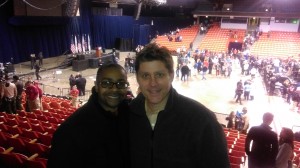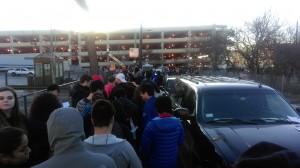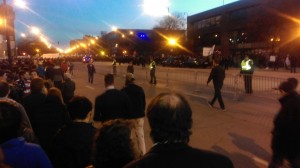
Earlier tonight, I was among the thousands of people who journeyed to the UIC Pavilion for the Donald Trump rally. Clearly, the event meant different things to different people: rally, speech, protest, performance art, commercial enterprise.
And all of those activities—and then some—transpired. Only Trump didn’t take part in any of it, as security concerns raised by a large number of protesters prompted its “postponement.”
By scheduling an appearance, though, Trump set the stage for any number of individuals to take up those tasks. And while Trump didn’t show up, there was plenty to engage the senses.
Here are this recovering journalist’s 7 Trump Rally Take-Aways:
1. This Was a Cancellation, Not a Postponement
The Trump campaign is apparently calling this a postponement but anyone who was on hand can testify that there is little chance Trump will be speaking at a large Chicago venue any time soon. Certainly not under the same free-for-all rally-style circumstances—and by “free-for-all,” I actually mean an event where the tickets are free of charge, as this one was.
Anyone could secure a ticket and, thus, take steps to disrupt the show from going as the Donald had planned.
2. You’re Right, Ben Carson: Donald Trump is ‘Shiny’
A few weeks ago, shortly after he dropped out of the race, Ben Carson was asked by TV personality Katie Couric to offer one-word descriptions of the candidates still in the fray for the Oval Office. Of Trump, he said, “Shiny.” Elaborating for a puzzled Couric, Carson explained that people can’t help but look at shiny objects.
I am aghast at the support Trump has received. It seems we are in some surreal (bad) dream that has him playing the Presidential front-runner for the Republicans. Yet, I halted my work early on an otherwise-mundane Friday afternoon to hop on the train and stand in line for more than two hours to see this train wreck with my own eyes.
Shiny, indeed.
3. Attendees Were Wildly Diverse, Mostly Well-Mannered
When I showed up 90 minutes before the scheduled 6 p.m. start, the line was at least a half-mile long. Not only have I never been in a line this long, I didn’t believe lines of this length could exist. My “community” consisted of the hundreds who strode past and stood in front of and behind me within my vision and hearing.

They ran the gamut of age, ethnicity, and judging by dress and manner, socio-economic class. A minority of people declared their support for Trump through buttons, shirts, hats and other items. Another, relatively small number of people declared their opposition through similar means. Most, like me, were hard to “read.”
In the two-plus hours that I was outside the Pavilion, before going inside, I witnessed no physical confrontations and fewer than five verbal jousts.
4. There Was a Conspicuous Lack of Event Leadership
Like most others, I walked the distance to the end of the line around 4:30 p.m.—only to have the line break down (after nearly two hours) during the final stages of approaching the Pavilion entrance. What had been an orderly line mushroomed into an amorphous mob. The doors had opened at 3 p.m., and while thousands were already inside, as it turns out there was more room.
At any rate, whoever was in charge of the flow of would-be attendees didn’t stick with it. Or maybe nobody was “in charge”? Consequently, people who were strolling in the area could—and did—simply jump into the crowd at this last stage. The crowd was gradually pressing in, and an undercurrent of danger began creeping in, along with collective resentment and restlessness.
When you’ve paid $0 for your ticket, non-buyer beware: you get what you pay for.

After nearly 20 minutes of this standstill, side doors opened and people began streaming out. Tired of waiting and wondering if we’d ever get through the proper entrance, a group of us began shuffling through this unexpected opening.
Within 15 seconds, word began circulating that the event had been canceled, but that did little to discourage those on the outside from wanting to finally get inside.
5. After the Event Was Canceled, A Sort of Muted Chaos Reigned
I cannot speak to the activities or vibe inside the Pavilion before 6:30 p.m. or so. But in the immediate aftermath of the event’s cancellation, a sense of muted chaos permeated. There were pockets of tension, celebratory chants among Trump foes, some physical altercations involving shoves and punches, and police leading a small number of individuals out.
A young man stormed the stage, was pulled off…and then the same individual, a few minutes later, created another sort of disturbance that led to his being escorted out by officers. Most simply observed, with hundreds of smartphones dotting the landscape and capturing video and photos.
6. Tensions Escalated Outside
About 15 minutes after my side-door entrance into the Pavilion, a voice repeatedly boomed over the sound system: “Attention, attention: the event is now over, please exit the building. Thank you.”
Gradually, the crowd dispersed and streamed outside. In the three or four minutes that my friend and I lingered, we saw a burly young man get a head of steam and barge, blind side, into a smaller young man. Both went crashing to the ground. A man in a business suit—it was unclear if he was acting in any official capacity—stepped between them, then someone else violently shoved the peacemaker in the suit.
The moment teetered on the brink. Would this escalate into a melee? No police officer was in the immediate vicinity—they seemed to be strategically deployed to open spaces away from spots where people were clustered. The situation seemed to cool, but my friend and I moved briskly out of the area.
7. Even When Divided Politically, There Are Ties That Bind
An hour earlier, standing in line with my friend, he mentioned a time in his life when he served in the military. This piqued the curiosity of the man in front of us, a Trump supporter who entered the conversation.
Turns out they both served in the Air Force. Handshakes and stories of various posts and experiences ensued between this fellow citizen and my friend, a non-Trump supporter. They didn’t discuss politics—their common experience, years of service to country, and mutual respect easily trumped that.
“You know,” said the other man, pointing to a contingent of anti-Trump demonstrators who vocally walked past our spot in line. “We served so that they could have their freedom of speech. And I can disagree with their speech, too.”
Related Posts:
Redact This! A Recovering Journalist’s Look at the (REDACTED) Administration of Chicago Mayor Rahm Emanuel
Bruce Rauner Flunking Simple PR Test: Administering His Campaign Facebook Page
